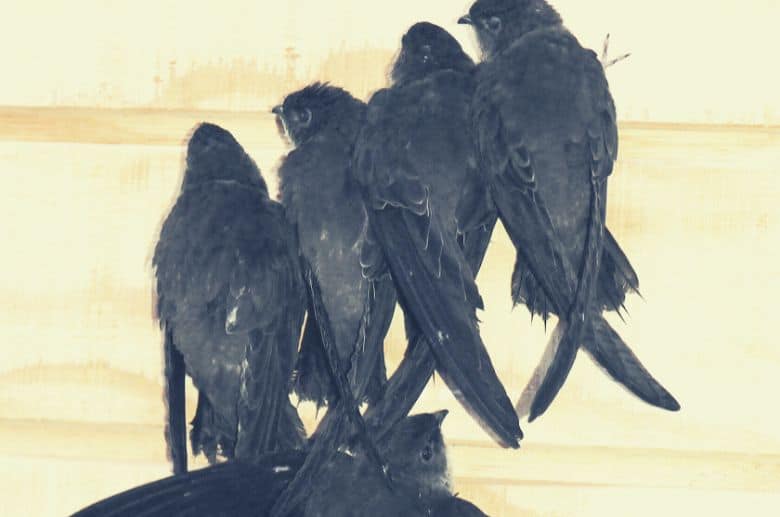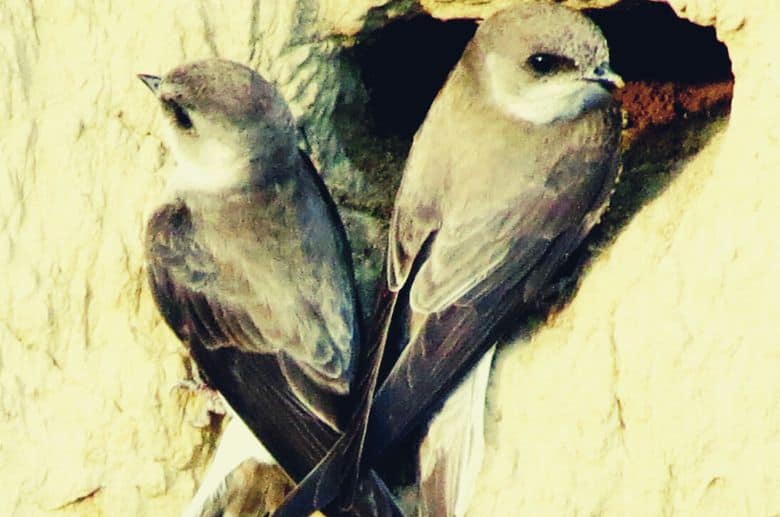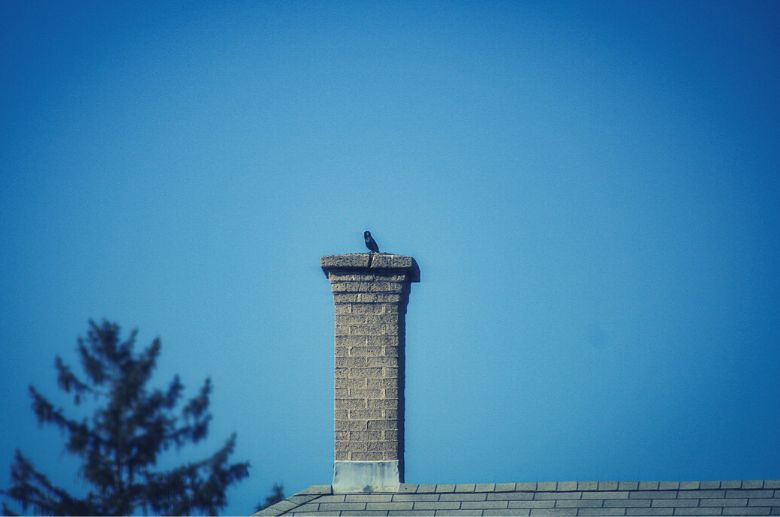Have you ever been sitting in your backyard, enjoying the nice weather and a good book, when suddenly you hear a loud screeching noise?
If so, there’s a good chance you heard chimney swifts. While they may be fun to watch, no one wants them nesting in their chimney. That’s why it’s essential to know how to get rid of chimney swifts safely and effectively.
Fortunately, you can take steps to get rid of them safely and effectively. Keep reading for more information.
Why Do Chimney Swifts Live in Chimneys?
There are several reasons why chimney swifts prefer to live in chimneys.
- First, the inside of a chimney is protected from bad weather and predators.
- Second, a chimney provides a good place for birds to build their nests.
- Additionally, insects are abundant in human dwellings, which makes it easier for the birds to find food.

Do Swifts Nest in Chimneys?
Yes, Chimney swifts do nest in chimneys. Chimney Swifts are a type of bird adapted to living in chimneys and other small, vertical spaces.
Chimney Swifts build their nests inside chimneys using materials such as twigs, feathers, and saliva.
The birds typically lay two or three eggs per clutch, and both parents help incubate them. Once the chicks hatch, they are fed a diet of insects.
Interestingly, chimney swifts use the same nesting site year after year. This means that if you have a swift living in your chimney, there’s a good chance it will return to nest there again next year.
How Long Will Chimney Swifts Stay in Their Chimney?
Chimney swifts stay in their chimney for around six weeks while they raise their chicks. Once the chicks are old enough to fly, the family leaves the chimney and heads back to their wintering grounds.
Therefore, if you’re wondering how long you have to deal with a chimney swift in your home, the answer is six weeks or less. However, it’s important to note that the birds can return to nest in the same chimney yearly.
Do Chimney Swifts Return to Nest in the Same Chimney?
Chimney swifts often return to a nest in the same chimney year after year, and this is because chimney swifts are loyal to their nesting sites. Once a swift finds a suitable chimney, it will often return to that same chimney year after year.
This means that if you have a swift living in your chimney, there’s a good chance it will return to nest there again next year.
How Do I Know if I Have a Chimney Swift Nest in My Chimney?

The best time to check if you have a chimney swift is to wait and look around during the evening hours. That’s when they fly in to roost for the night, and you may hear them twittering as they enter the chimney.
Another way to tell if you have a nest is by looking up the chimney inside your home. If you see bird droppings on the fireplace, that’s a good sign.
You can also try and listen for the bird’s vocalization, as they will often perch on the roof near the chimney and make a repetitive twittering noise. If you hear this sound, there is likely a nest in your chimney.
Are Chimney Swifts Dangerous?
Chimney swifts are dangerous, and a chimney’s swift invasion presents a significant danger to human health. Ingesting their feces can lead to cholera and other serious diseases.
Chimney swifts are also a fire hazard because their nests are made of sticks, leaves, and other materials that can easily catch fire. If a nest catches fire, it can quickly spread to the rest of the house, causing significant damage or even death.
What’s more, chimney swifts are a nuisance, and their constant noise can be disruptive, especially when they are most active at night. They also tend to congregate in large numbers, making it difficult to enjoy time outdoors without being constantly bothered by them.
——
Do You Need to Hire Chimney & Fireplace Expert?
Get free quotes from qualified experts near you. No commitment required!
——
Do Chimney Swifts Carry Diseases?
Chimney swifts carry diseases and have a wide range of foreign bacteria and diseases. They are also known to be vectors for several diseases, including histoplasmosis, salmonellosis, and psittacosis.
Chimney swifts have roost in large numbers in chimneys and other structures. When they do this, their droppings can accumulate on the structure itself and anything else they come into contact with. This can pose a severe health risk to humans and animals alike.
Do Chimney Swifts Poop in the Chimney?

Chimney swifts do poop in the chimney, and they often leave their waste outside of the structure. Homeowners can often find these droppings on the structure itself and anything else they come into contact with.
Chimney swifts are also known to urinate inside the chimney. This can lead to an unpleasant smell and can also be a health hazard.
Chimney swift urine is highly acidic and can eat away at mortar, bricks, and other materials. In some cases, it can even cause structural damage to the chimney itself.
How Do I Get Rid of a Swift Bird in My Chimney? Step-by-Step Guide
Chimney swifts are protected under the Federal Migratory Bird Treaty Act, which means you cannot get rid of chimney swifts until the young ones have left.
If birds are seen flying around or heard within the chimney, but no hatchlings are heard, the eggs in the nest have just been laid and will take six weeks to hatch.
According to the Houston Audubon Society, hatchlings can be heard chirping within the chimney if they reach maturity in less than four weeks.
Here are the steps to get rid of a swift bird in your chimney safely and effectively:
Step 1: Ensure the Damper is Shut
If you have a fireplace, the first step is to ensure the damper is shut. The last thing you want is a bird to come down your chimney and get into your home.
Step Two: Set up a One-Way Door
The next step is to set up a one-way door. This will allow the bird to leave your chimney but not be able to get back in. You can purchase a one-way door at most hardware stores.
Step Three: Wait for the Bird to Leave
Once the one-way door is in place, it is simply a waiting game. The bird will eventually leave your chimney, and you won’t have to worry about it anymore!
Swift birds are migratory creatures, so it shouldn’t take too long. Be patient and wait for the bird to fly away.
Step Four: Pack the Bottom of the Chimney with Insulation
If the birds chirping sound keeps you up at night, you can try packing the bottom of the chimney with insulation. This will muffle the sound and make it easier for you to sleep. Always cap chimneys lined with metal, as birds that enter can become trapped.
Step Five: Use the Right Measures
Consider contacting animal control first. Afterward, call to schedule an inspection from a chimney sweeper to avoid a fire risk by unblocking the chimney from the nest residue. This will help you eliminate a swift bird in your chimney and prevent future problems.
If you follow these steps, you can get rid of a swift bird in your chimney safely and effectively.
How to Keep Chimney Swifts Out of Your Chimney

You can use several ways to keep your chimney swift protected and prevent the birds from making your chimney their home. They include:
- Install a chimney cap: A chimney cap is a metal cover that fits over the top of your chimney. It has holes that allow smoke to escape but keep birds from getting in.
- Close off your chimney: If you don’t use your fireplace, close off the opening to your chimney with a screen or cap. This will keep birds from flying down the chimney and getting stuck.
- Keep trees and shrubs trimmed: Trimmed branches will prevent birds from roosting on them and then jumping into your chimney.
- Repel birds: You can use bird repellent to keep birds away from your chimney. There are several repellents, including visual, auditory, and chemical.
Conclusion
Getting rid of chimney swifts can be difficult, but it is possible. If you have a chimney swift stuck in the chimney, there are many different methods you can use, and the most important thing is to find the one that works best for you.
If you need any help, be sure to contact a professional. They will be able to help you get rid of these birds safely and effectively.






